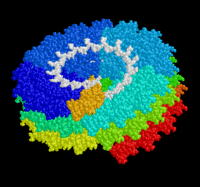Sandbox TMV
From Proteopedia
(Difference between revisions)
| Line 8: | Line 8: | ||
==Caspar Carboxylates== | ==Caspar Carboxylates== | ||
Two clusters of acidic amino acids are thought to be important for the disassembly of the <scene name='2tmv/2tmv_lockwasher_ring/1'>helical structure of TMV</scene>. When the virus enters cells, the higher pH and lower calcium levels increase the repulsion of neighboring carboxylates, destabilizing the capsid. This concept was originally proposed by Caspar and subsequently examined by site-directed mutagenesis <ref>Caspar carboxylates: the structural basis of tobamovirus assembly. Wang H, Planchart A, Stubbs G. Biophys. J. 1998, 74, 633-638.</ref>. Several carboxylates were identified including <scene name='2tmv/2tmv_carbox1/2'>Glu50 and ASP77</scene>, which contact each other in the helical stack by <scene name='56/561621/Hydrogen_bond/1'> hydrogen bond</scene> (look closely at the <scene name='2tmv/2tmv_carbox1_closeup/1'>two subunits that overlap</scene> in this lockwasher complex), and a cluster of four acidic amino acids, <scene name='2tmv/2tmv_carbox2/2'>GLU95, GLU97, GLU106 and GLU109</scene>, near the center of the ring. | Two clusters of acidic amino acids are thought to be important for the disassembly of the <scene name='2tmv/2tmv_lockwasher_ring/1'>helical structure of TMV</scene>. When the virus enters cells, the higher pH and lower calcium levels increase the repulsion of neighboring carboxylates, destabilizing the capsid. This concept was originally proposed by Caspar and subsequently examined by site-directed mutagenesis <ref>Caspar carboxylates: the structural basis of tobamovirus assembly. Wang H, Planchart A, Stubbs G. Biophys. J. 1998, 74, 633-638.</ref>. Several carboxylates were identified including <scene name='2tmv/2tmv_carbox1/2'>Glu50 and ASP77</scene>, which contact each other in the helical stack by <scene name='56/561621/Hydrogen_bond/1'> hydrogen bond</scene> (look closely at the <scene name='2tmv/2tmv_carbox1_closeup/1'>two subunits that overlap</scene> in this lockwasher complex), and a cluster of four acidic amino acids, <scene name='2tmv/2tmv_carbox2/2'>GLU95, GLU97, GLU106 and GLU109</scene>, near the center of the ring. | ||
| - | There are phosphate carboxylates in the structure of the virus, | + | There are phosphate carboxylates in the structure of the virus, the <scene name='56/561621/Phosphate_carboxylates/1'>phosphate-carboxylates</scene> are presented in the color teal in the molecule. They are calcium-binding sites along with the carboxylates. When phosphate-carboxylates bind to calcium it makes the capsid more stable. When the phosphate- carboxylates or the carboxylates are not present then capsid will be unstable, since it will not be able to bind to calcium.Here is a display of pbd 2TMV showing the <scene name='56/561621/Calcium/3'>calcium</scene> binding to carboxylates in order to stabilize the capsid. |
This section complements the article on [http://www.rcsb.org/pdb/static.do?p=education_discussion/molecule_of_the_month/pdb109_1.html Tobacco Mosaic Virus] in the | This section complements the article on [http://www.rcsb.org/pdb/static.do?p=education_discussion/molecule_of_the_month/pdb109_1.html Tobacco Mosaic Virus] in the | ||
Revision as of 16:33, 14 November 2013
Tobacco Mosaic Virus
| |||||||||||
3D structures of tobacco mosaic virus
Updated on 14-November-2013
2om3, 2xea – TMV coat protein + RNA - CryoEM
2tmv – TMV coat protein + RNA - fiber
References
Primary Reference
Visualization of protein-nucleic acid interactions in a virus. Refined structure of intact tobacco mosaic virus at 2.9 A resolution by X-ray fiber diffraction., Namba K, Pattanayek R, Stubbs G, J Mol Biol. 1989 Jul 20;208(2):307-25. PMID:2769760
Additional References
- ↑ Caspar carboxylates: the structural basis of tobamovirus assembly. Wang H, Planchart A, Stubbs G. Biophys. J. 1998, 74, 633-638.
Created with the participation of Jaime Prilusky, Eran Hodis, David S. Goodsell.

